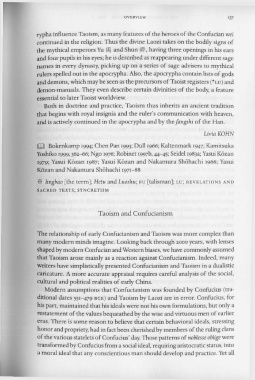Page 177 - The Encyclopedia of Taoism v1_A-L
P. 177
OVERVI EW I37
rypha influence Taoism, as many features of the heroes of the Confucian wei
continued in the religion. Thus the divine Laozi takes on the bodily signs of
the mythical emperors Yu ~ and Shun ~ , having three openings in his ears
and four pupils in his eyes; he is described as reappearing under different sage
names in every dynasty, picking up on a series of sage advisers to mythical
rulers spelled out in the apocrypha. Also, the apocrypha contain lists of gods
and demons, which may be seen as the precursors of Taoist registers (*LU) and
demon-manuals. They even describe certain divinities of the body, a feature
essential to later Taoist worldview.
Both in doctrine and practice, Taoism thus inherits an ancient tradition
that begins with royal insignia and the ruler's communication with heaven,
and is actively continued in the apocrypha and by the fangshi of the Han.
LiviaKOHN
W Bokenkamp 1994; Chen Pan 1993; Dull 1966; Kaltenmark 1947; Karnitsuka
Yoshiko 1999,362-66; Ngo 1976; Robinet 1997b, 44-45; Seidel 1983a; Yasui Kozan
1979; Yasui Kozan 1987; Yasui Kozan and Nakamura Shohachi 1966; Yasui
Kozan and Nakamura Shohachi 1971-88
* lingbao [the term]; Hetu and Luoshu; FU [talisman]; LU; R EVELATIONS AND
SACRED TEXTS; SYNCRETISM
Taoism and Confucianism
The relationship of early Confucianism and Taoism was more complex than
many modern minds imagine. Looking back through 2000 years, with lenses
shaped by modern Confucian and Western biases, we have commonly assumed
that Taoism arose mainly as a reaction against Confucianism. Indeed, many
writers have simplistically presented Confucianism and Taoism in a dualistic
caricature. A more accurate appraisal requires careful analysis of the social,
cultural and political realities of early China.
Modern assumptions that Confucianism was founded by Confucius (tra-
ditional dates 551- 479 BC E) and Taoism by Laozi are in error. Confucius, for
his part, maintained that his ideals were not his own formulations, but only a
restatement of the values bequeathed by the wise and virtuous men of earlier
eras. There is some reason to believe that certain behavioral ideals, stressing
honor and propriety. had in fact been cherished by members of the ruling clans
of the various statelets of Confucius' day. Those patterns of noblesse oblige were
transformed by Confucius from a social ideal, requiring aristocratic status, into
a moral ideal that any conscientious man should develop and practice. Yet all

